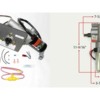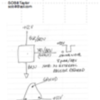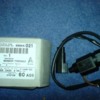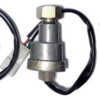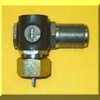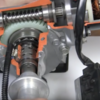Guys listen! I really don't get all the fuss about finding a Capri steering column and saving your own etc. Why don't just bloody buy the EZ and fit it?? Before you are done messing around with all that you have spend so much time that I simply don't think it is worth it. The EZ works flawless and is specially designed and manufactured to fit the Pantera. It is a match for your blinker stalk, plastic fairing, steering wheel, Ignition lock and your steering rack. It comes with a harness for all incl. the speed sensor and the only thing you need to consider is a bit of sheet metal modification where it mounts.
Sometimes its just not worth it to re-invent the wheel when some clever people already invented it several times ;-)
I am of course now prepared to get a lecture in how interesting and challenging it is to re-invent the wheel, but honestly you know my opinion and if it is not clear I have the EZ installed and I am pleased with it 100%
quote:Originally posted by PanteraDoug:
It is fun building it yourself.
The President, Trump, won't let us buy out of the country now. We can sell, but not buy.
If we do, he puts our name on a list and someone will come and "explain it to us" in person. Hopefully we don't disappear.
It's a new world for us now. He has a boyfriend too. We call him Putti.
One thing that is for sure is if you order your EZ EPAS no one will try to stop you. You can currently benefit from the favorable exchange rate between USD and EURO. And Trump what does he have to do with all this now? Just basically ignore him if he is not your cup of Tea I would say.
Sometimes it's just a good discussion, plus if I can engineer an equally good solution that costs me $150 and some free time then I'm ahead and by documenting it others might be too. That said I may very well end up with one of the two commercial options.
The steering column is from a Mk1 Ford Capri, I do have a spare. The challenge is that Capri's have become collector items in their own right so spares like this and the ignition switch have substantially increased in cost.
Interestingly I came across an EPS system for a MK1 Capri/Escort for sale in the UK, made from the Corsa unit that Doug so loathes.
http://www.carandclassic.co.uk/car/C139628
Julian
The steering column is from a Mk1 Ford Capri, I do have a spare. The challenge is that Capri's have become collector items in their own right so spares like this and the ignition switch have substantially increased in cost.
Interestingly I came across an EPS system for a MK1 Capri/Escort for sale in the UK, made from the Corsa unit that Doug so loathes.
http://www.carandclassic.co.uk/car/C139628
Julian
Julian it is such a good discussion that we have in fact had it twice now (at least) I am with you that it is fun and I am guilty my self in many matters. But on this one I tend to lean against starting with an EZ and then consider the rest of the mod the actual fun.
thanks larry,Scott at Sacc restoration is working with me,as soon as I can fiqure out how to post pictures (not very computer literate) I will show you guys what I'm doing,EPAS Performance in FLA is not a bad kit its just about 2 inches to long were the bracket bolts Scott is working on a fix for that it comes with what looks like a capri/pantera colum
jimmy
jimmy
Here is the reply I received from Bill Taylor regarding the S2000 steering rack.
"Steve,
I did install a narrowed S2000 power rack and discovered the following problems:
1) 0.75 turns lock-to-lock steering. Sort of like a go-cart. This is caused by the fact the S2000 has very long steering arms (and rack travel to suit those arms) relative to the Pantera (which is about 3.5 turns lock-to-lock ..... much too slow for a sports car).
2) The S2000 is a rack and pinion with a coaxial motor and a separate control box which requires only digital vehicle speed pulses as an input. But the S2000 rack must be shortened by 6 inches to fit the Pantera frame and frame modification to the Pantera to fit the rack are not trivial.
2) Liability. I could just hear a lawyer at the trial after I wrecked a school buss full of handicapped children on the freeway ask, for the benefit of the jury, where I got my mechanical engineering degree and how much experience I had designing steering systems at a major car manufacturer.
I wanted an in-column power assist system, but the only one available at the time was from the Toyota Prius. The Prius system is extremely complicated. It has four digital bus inputs and even if you could sort all the buss interfaces out, it looked too big to fit under the Pantera dash.
A big, expensive, time consuming mistake.
Bill Taylor"
I did a little searching and found Unisteer. This seems like an option that could be mounted on the firewall under the car. Anyone have there car up in the air to look at the measurements? I need to call the company to see if there is an option for speed input.
"Steve,
I did install a narrowed S2000 power rack and discovered the following problems:
1) 0.75 turns lock-to-lock steering. Sort of like a go-cart. This is caused by the fact the S2000 has very long steering arms (and rack travel to suit those arms) relative to the Pantera (which is about 3.5 turns lock-to-lock ..... much too slow for a sports car).
2) The S2000 is a rack and pinion with a coaxial motor and a separate control box which requires only digital vehicle speed pulses as an input. But the S2000 rack must be shortened by 6 inches to fit the Pantera frame and frame modification to the Pantera to fit the rack are not trivial.
2) Liability. I could just hear a lawyer at the trial after I wrecked a school buss full of handicapped children on the freeway ask, for the benefit of the jury, where I got my mechanical engineering degree and how much experience I had designing steering systems at a major car manufacturer.
I wanted an in-column power assist system, but the only one available at the time was from the Toyota Prius. The Prius system is extremely complicated. It has four digital bus inputs and even if you could sort all the buss interfaces out, it looked too big to fit under the Pantera dash.
A big, expensive, time consuming mistake.
Bill Taylor"
I did a little searching and found Unisteer. This seems like an option that could be mounted on the firewall under the car. Anyone have there car up in the air to look at the measurements? I need to call the company to see if there is an option for speed input.
Attachments
Ok, just pause for a second guys.
If you're going to custom build an EPAS, why put it in the cabin? Its already cramped enough.
This about mounting the EPAS under the front trunk floor, there is room. It does require fabrication in an area that's a pain to work in.
This has other benefits, you can move the steering shaft firewall pass through further up, and out of the way of your feet.
Only speaking from experience since I did I already custom fabbed a EPAS.
The unisteer looks very similar to my cut down unit based on size, if I were to do it over I would start with a one of the curve programmable race EPS systems.
Dave
If you're going to custom build an EPAS, why put it in the cabin? Its already cramped enough.
This about mounting the EPAS under the front trunk floor, there is room. It does require fabrication in an area that's a pain to work in.
This has other benefits, you can move the steering shaft firewall pass through further up, and out of the way of your feet.
Only speaking from experience since I did I already custom fabbed a EPAS.
The unisteer looks very similar to my cut down unit based on size, if I were to do it over I would start with a one of the curve programmable race EPS systems.
Dave
Regarding the CAN bus interfacing to many EPAS units, vehicle speed is transmit over the CAN system. While there is no way (without a coding degree) to alter the assist vs speed you can alter the incoming message. The ECU I use for my fuel injection has user configurable CAN bus outputs. All I need to do is figure out what message the EPAS system is looking for and program the injection ECU to send it. If I dont like the assist curve I just alter the message to suit.
PANTERA Doug,i have that unit now im trying to mount scott is working on the same one and it has the Capri/Pantera column,according to scott its 2 inches to long so you need to move the mount on the column donw to bring the steering up 2 inches or make an adapter and move it up roughly 2 inches if i could figure out to shrink the pictures of my car to fit this format i could show you but im not very computer literat
I know for certain that there are no inputs that would be directly adjustable with a potentiometer on the Cobalt SS EPAS system. I am uncertain at this point whether the CAN bus input is just a Speed message and the EPAS does the assist calculation itself or if there is a requested assist message and the ECU does the thinking. The only way to use a potentiometer would be to have a microprocessor built in that converted the potentiometer input to a CAN message.
If it is calculated by the EPAS which I suspect it is I would have the ECU output a modified vehicle speed output message. For example rather than sending a message from the ECU to the EPAS saying the car is going 50 MPH I would alter the multiplier to say the car is going 100 MPH. This would in effect reduce the power steering assist. If you made a simple circuit with a potentiometer and processor that output the CAN message and altered it by potentiometer position it would have the same effect.
While on the VSS topic, anyone have any wisdom on mounting the VSS unit under the dash, at the speedometer, instead of at the ZF angle adaptor?
With correct adapter fittings, seems it could be completely hidden under the dash and thus not require running wires from engine bay.
Thoughts? Ideas?
Larry
With correct adapter fittings, seems it could be completely hidden under the dash and thus not require running wires from engine bay.
Thoughts? Ideas?
Larry
Larry,
That's the way EZ Electric did the prototype. They mounted the VSS at the speedometer end of the cable (under the dash), then used a cable a few inches long to connect the VSS to the speedometer. I'm sure you could order it that way. They told me they could also supply a GPS VSS.
I already had a VSS, since I'd converted my OEM speedometer to electric operation years ago. The VSS I had was made by Veglia for a bunch of different '80's Italian cars (Ferrari, Alfa 164, etc.) including the Pantera Si. That's it in the photo below. I sent it to EZ Electric so they could calibrate their EPAS electronics to work with it. I then used an Autometer GPS unit to drive my speedometer.
Speaking of electric speedometers, SpeedHut has an interesting new product for converting mechanical speedometers to GPS operation. It's a GPS/VSS box that drives a short speedometer cable that screws into your mechanical speedometer.
http://www.speedhut.com/ecomme...rive-Speed-Converter
That's the way EZ Electric did the prototype. They mounted the VSS at the speedometer end of the cable (under the dash), then used a cable a few inches long to connect the VSS to the speedometer. I'm sure you could order it that way. They told me they could also supply a GPS VSS.
I already had a VSS, since I'd converted my OEM speedometer to electric operation years ago. The VSS I had was made by Veglia for a bunch of different '80's Italian cars (Ferrari, Alfa 164, etc.) including the Pantera Si. That's it in the photo below. I sent it to EZ Electric so they could calibrate their EPAS electronics to work with it. I then used an Autometer GPS unit to drive my speedometer.
Speaking of electric speedometers, SpeedHut has an interesting new product for converting mechanical speedometers to GPS operation. It's a GPS/VSS box that drives a short speedometer cable that screws into your mechanical speedometer.
http://www.speedhut.com/ecomme...rive-Speed-Converter
Attachments
quote:Originally posted by LF - TP 2511:
While on the VSS topic, anyone have any wisdom on mounting the VSS unit under the dash, at the speedometer, instead of at the ZF angle adaptor?
With correct adapter fittings, seems it could be completely hidden under the dash and thus not require running wires from engine bay.
Thoughts? Ideas?
Larry
Larry there is not enough space behind the speedo to fit the speed sensor there. It really is not a big job to pull the wire thru and strapped to the speedo cable. It is for sure faster than fumbling around behind the speedo and in worst case removing the dash. If you insist to fit it behind the speedo there is however an option using a 90° adapter and the benefit is that they come with various ratios so that you can get your speedo to show accurate speed. I fitted my speed sensor at the ZF together with a 13% ratio decrease adapter (180°) so that my speedo is now accurate. It looks like a christmas tree coming out of the ZF but that didn't bother me so far.
Attachments
quote:They mounted the VSS at the speedometer end of the cable (under the dash), then used a cable a few inches long to connect the VSS to the speedometer. I'm sure you could order it that way.
Thanks, David.
That seems like a cleaner and "simpler???" approach for the VSS signal.
Good to know it is likely an option from them.
Any idea why they went with the ZF mounted solution?
Larry
quote:a 90° adapter and the benefit is that they come with various ratios so that you can get your speedo to show accurate speed.
Thanks.
That right-angle adaptor might also be useful to free up space for other under-dash modifications.
Larry
quote:The steering input is derived from the torque sensor in the steering column and speed is from the VSS but might be translated by the BCM in the serial port or through the CAN communication. This is very difficult for a backyard wrench turner to address this need. To accomplish this a microprocessor needs to be programmed to fake the BCM signal."
I strongly suspect that is what the after-market units using a potentiometer are doing.
To do the assist properly, two inputs are needed:
tire resistance, measured by sensing the torque needed to rotate steering wheel. This is done internally on the EPS shaft.
level of assist, dependent on vehicle speed and controlled by an external-to-the EPS unit VSS input.... or the potentiometer through a suitable controller.
As for the internal torque sensor, this little YouTube video with a cut-away unit helps in displaying the internal workings of an EPS.
https://youtu.be/H-kBebxMPrw
Larry
Attachments
quote:Larry wrote:
Any idea why they went with the ZF mounted solution?
Larry,
They went with the VSS mounted on the transaxle because it made the installation a bit easier. The VSS they use is made by VDO. As I mentioned, they are quite happy to supply which ever VSS option suits the customer.
Just to clarify, the under-dash VSS doesn't mount directly to the speedometer, it connects to the speedometer by a short speedo cable.
quote:Originally posted by PanteraDoug:
So if I am getting your thought on this right, you think the EPS just needs a 12v power source and a way to know how fast the vehicle is moving? That is a "stand alone"?
Wouldn't that make the signal from the VSS necessary and that signal what would be modified somehow with the "dimmer switch", probably with some kind of a mini circuit contained within to 'translate' that signal to a CAN signal if it is not already?
What type of signal does a VSS produce now?
In a sense yes, most modern vehicle modules are just that. They each control their own items and talk to each other via CAN to gain more info. For example an abs module will have four wheel speed sensors. The speed sensors will output either a digital square wave or a sine wave. The abs unit will count these pulses and calculate wheel speed. Rather than trying to connect the four wheel speed sensors to other devices which would have to each do their own calculations the ABS unit merely tells the other modules what the speeds are. As for the EPAS unit it is not quite so simple as a speed input and power. There is a master module in the car which is kind of like a hub. This is usually the BCM or the dash cluster. This module has to first send out a wake up command to all of the other modules to get them ready to receive and send data. After that the modules start to transmit their respective data and receive relevant data from other modules. This is what the Cobalt EPAS is looking for. Without knowing the exact identifier and configuration of the CAN bus data required the EPAS will not be fully functional. For interest sake A can bus message looks something like
000005a1 8 11 22 33 44 55 66 77 88
Imagine a hundred of these flying around the can bus per second. Now imagine trying to figure out which one of those is the one you are looking for. Once you find it you then have to figure out its structure. This is why there aren't a lot of guys out there doing this. Some of the older EPAS units dont use this such as the MR2 units however most if not all of the new ones do.
In is interesting to note that CAN communication is different then say your computer on a network. On a computer network when you communicate with something you create a direct link and flow communication back and forth.
A CAN Bus network is a chatty network. There are no direct links but rather all devises are spewing out data or information. If 2 talk at the same time the device with higher priority is allowed to speak.
If you want to know information from something you simply listen. If an EGT sends out a value you wait for a message to pass down the network from the EGT and just read the values as it goes by.
A CAN Bus network is a chatty network. There are no direct links but rather all devises are spewing out data or information. If 2 talk at the same time the device with higher priority is allowed to speak.
If you want to know information from something you simply listen. If an EGT sends out a value you wait for a message to pass down the network from the EGT and just read the values as it goes by.
Well I'm a mechanical guy and got left behind when we started talking about buses in Canada!
Does this $150 unit provide what is required to use full functionality of the Cobalt/Vue EPAS? It seems popular with the classic Mustang guys.
http://www.ebay.com/itm/NEW-Ch...AOSwiDFYQ2tN&vxp=mtr
Does this $150 unit provide what is required to use full functionality of the Cobalt/Vue EPAS? It seems popular with the classic Mustang guys.
http://www.ebay.com/itm/NEW-Ch...AOSwiDFYQ2tN&vxp=mtr
quote:Originally posted by Joules:
Well I'm a mechanical guy and got left behind when we started talking about buses in Canada!
Does this $150 unit provide what is required to use full functionality of the Cobalt/Vue EPAS? It seems popular with the classic Mustang guys.
http://www.ebay.com/itm/NEW-Ch...AOSwiDFYQ2tN&vxp=mtr
One of my buddies just picked up one of those. I will let you know how it works as soon as I hear from him.
So my buddy says he got his working with the little black box with the rheostat. He used the VUE column. The maker of the little unit said it would not work on the Cobalt system so there is definitely a difference in data. He does not have functional speed assist yet however will be doing some testing with integrating it into his megasquirt ECU. His one gripe is that there is no self centering.
quote:PanteraDoug wrote:
The other thing about these kits is how sure are "you" about the dependability of them in a high performance vehicle, i.e., what do you do if the unit fails at over 100 mph and you can't steer it?
If my EZ Electric system failed at 100 mph, I wouldn't be aware of it because it provides no power assist at that kind of speed. Even at low speeds, if it fails or I decide to disable it, the steering reverts back to normal, non-assisted, Pantera steering.
quote:PanteraDoug wrote:
So, ON THIS BOLT IN "KIT" (supposedly a PLUG AND PLAY), Either you are going through the floor with this two inches or the steering wheel is going to be 2" closer to you OR you are doing away with the original Pantera lock/ignition switch location and the ignition cover?
I'm sure Scott will correct me if I'm wrong, but the only issue with the EPAS Performance kit (as discussed earlier in this topic) that SACC now sells, is the mounting bracket (as developed by EPAS Performance) being off by about two inches,...that's all. The unit is not two inches too long. The issue is mounting location (height) not length. Scott is developing a revised bracket that will rectify the issue.
Doug, IF I was to install power steering (for my little wife's convenience) on our Pantera, I would go with the electro-hydraulic unit from a '92-'95 U.S-spec MR-2 Turbo. That unit uses a conventional power-assisted rack and a hydraulic pump driven directly by a starter-sized electric motor inches away from the rack up front. The hoses are very short as is the response. It has it's own stand-alone black box that takes speed info from an electric speedo, if you choose to use the variable ratio assist. Very popular with off-road rally guys who use hand-made emulators instead of factory sensors. Developed by a close friend who has one in his 350-Chev powered Huffacker Fiero (ex-GTU racer). He now autocrosses it. With 12" gumballs up front, it's a handful without PS! He also has one in a Northstar V-8 powered Fiero street car.
quote:Originally posted by PanteraDoug:
Scott is not always completely revealing.
"Daddy, why is the sky blue". "Because". OK. Doesn't help the discussion.
Pictures are helpful.
I'm very glad that you feel safe with yours David.
I've had two here. The Vue and the Fiesta. Neither will turn without being powered up. Loose power, locked up.
I've already said I'm not installing this thing. That's for a bunch of reasons but I am interested in knowing how they work.
Act as you will but unlike others I'm not going to stomp around and act like a juvenile just because no one else agrees with me.
If you say I'm wrong, you are probably right, but when were you speaking to my wife?
Doug, WTF are you on, do you have any idea how ridiculous many of your posts and rants are? Do you realize you ARE the one stomping around like a juvenile! If you can't add anything to the discussion then just say nothing and follow along with others who are trying to have and adult conversation and like me you might learn something about the challenges along the way.
Julian
quote:I will now withdraw from this discussion by popular demand.
Baby, please don't go
Baby, please don't go
Baby, please don't go
Down to New Orleans
You know I love you so
Baby, please don't
It's hard enough for us Yanks to figure you out, Doug.
Being British and all probably makes it even more difficult for Julian.
We will now all join hands and sing Kum ba yah.
Larry
Larry,
I never took you for the Gospel choir type
I consider myself to have a pretty good sense of humor, but perhaps I'm not so into slapstick comedy
I never took you for the Gospel choir type
I consider myself to have a pretty good sense of humor, but perhaps I'm not so into slapstick comedy
quote:Doug, WTF are you on, do you have any idea how ridiculous many of your posts and rants are? Do you realize you ARE the one stomping around like a juvenile! If you can't add anything to the discussion then just say nothing and follow along with others who are trying to have and adult conversation and like me you might learn something about the challenges along the way.
I second that. I've seen so many serious technical threads ruined by PanteraDoug. Both by "humour", not my kind, with youtubes of old ladies fighting with handbags (WTF?), and with very firm statements on what will work, sometimes simply not correct. I, for a while, saw it as my God given obligation to correct these statements, so that newbies on this forum didn't make a costly/dangerous mistake, but I have given up.
This isn't Facebook...
quote:Originally posted by PanteraDoug:quote:Originally posted by Bosswrench:
Doug, IF I was to install power steering (for my little wife's convenience) on our Pantera, I would go with the electro-hydraulic unit from a '92-'95 U.S-spec MR-2 Turbo. That unit uses a conventional power-assisted rack and a hydraulic pump driven directly by a starter-sized electric motor inches away from the rack up front. The hoses are very short as is the response. It has it's own stand-alone black box that takes speed info from an electric speedo, if you choose to use the variable ratio assist. Very popular with off-road rally guys who use hand-made emulators instead of factory sensors. Developed by a close friend who has one in his 350-Chev powered Huffacker Fiero (ex-GTU racer). He now autocrosses it. With 12" gumballs up front, it's a handful without PS! He also has one in a Northstar V-8 powered Fiero street car.
My feeling on this after reviewing as much as I could get, I personally would only feel comfortable with a dedicated EPS rack. A real bolt in.
TY for this info Boss, I do appreciate it. I might even investigate that application...just to expand my horizons?
I will now withdraw from this discussion by popular demand.
Mine is a dedicated rack but is anything but a bolt on. I absolutely love the outcome but the process was quite a job.
I think the first thing is to locate a rack. The Pantera rack is not right an causes Bump steer by it's dimensions. People mask the problem by changing the rack height but you cannot get rid of it until the rack is addressed.
The ratio of the rack and movement of the rack must also be figured out. The hose positions need to be in a position you can work with as well.
If all that could be sorted out the electric pump is the easy part.
With the rack I used I spent much time in a suspension program working out the geometry. Even this only got me "close". When I got done bump steer was effected by both height of the rack and the distance between the pivot point.
The width of the rack was a adjusted using a threaded shaft. I cut the rack and tack welded the threaded rod in place and used a rebuild able ball joint so I could weld it on.
Once adjustments were made it was welded in place.
To get the rack to fit some structure was cut out. To fix that I made a box the rack bolted to then bolted the box in to replace the metal and even added a little rigidity in the area.
The rack is adjustable in height on the box.:

To fine tune the bump steer I spent a month of spare time messing with rack height and the rack width before welding it all up and tightening down the adjustments.

The result was Zero bump steer in the full rand of suspension travel (+/-) 1/32" full range:


With my setup I mounted the electric power steering pump where people put the battery drop down box:


This is both good and bad. It's a good spot to put it but a terrible spot to work on. Tightening hoses was working with cutting off and re-welding wrenches and getting your hands where you can't see what your doing.
Second issue is if I need to work on it again I have to remove the cooling tubes:

I am 100% pleased with how it operates. I like the ability to turn it off. I would however not recommend the exact route I took to get here.
However, it may lead to a better route!!
Perhaps drop the pump in from the top like the drop in batteries.
The real solution to this entire equation is finding or having made for public consumption a power steering rack purposely configured for this car.
If that could be done the process gets a 1000x easier.


This is both good and bad. It's a good spot to put it but a terrible spot to work on. Tightening hoses was working with cutting off and re-welding wrenches and getting your hands where you can't see what your doing.
Second issue is if I need to work on it again I have to remove the cooling tubes:

I am 100% pleased with how it operates. I like the ability to turn it off. I would however not recommend the exact route I took to get here.
However, it may lead to a better route!!
Perhaps drop the pump in from the top like the drop in batteries.
The real solution to this entire equation is finding or having made for public consumption a power steering rack purposely configured for this car.
If that could be done the process gets a 1000x easier.
Comp2,
How much too long is the Pantera's steering rack? Would moving the front spindles further out, by using longer front control arms, have the same effect as shortening the rack?
As far as the electric PS pump is concerned; it may help to use a pump with a remote reservoir. I believe late model Mini's use an electric PS pump with a remote reservoir. Ultimate Power Steering in Australia has one but it's a bit pricey (AUD $1,300 / http://www.ultimatepowersteeri...r-steering-pump-kit/ ). It also looks like the late model Mini pump to me.
How much too long is the Pantera's steering rack? Would moving the front spindles further out, by using longer front control arms, have the same effect as shortening the rack?
As far as the electric PS pump is concerned; it may help to use a pump with a remote reservoir. I believe late model Mini's use an electric PS pump with a remote reservoir. Ultimate Power Steering in Australia has one but it's a bit pricey (AUD $1,300 / http://www.ultimatepowersteeri...r-steering-pump-kit/ ). It also looks like the late model Mini pump to me.
quote:Originally posted by David_Nunn:
Comp2,
How much too long is the Pantera's steering rack? Would moving the front spindles further out, by using longer front control arms, have the same effect as shortening the rack?
I think it was about 1.5". Been a while since I looked at it. It has to do with the relationship between the pivot point on the steering rack and the pivot points on the control arms so changing the length of the control arm does not change anything.
Here is a good explanation from Longacre racing.
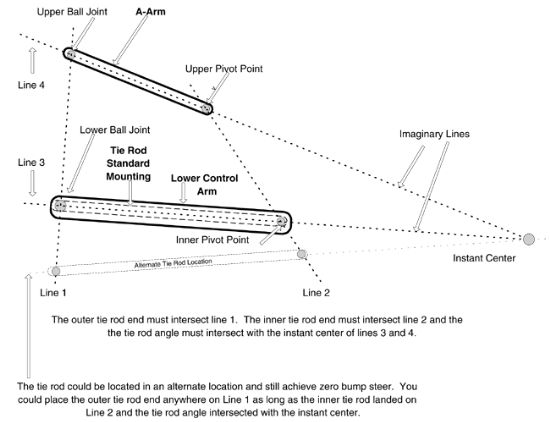

Any updates on a power steering kit for the Pantera? Who offers the best kit out there?
Add Reply
Sign In To Reply


